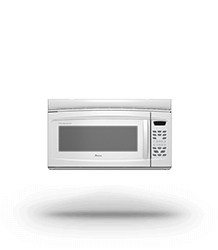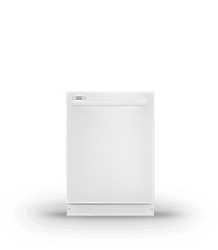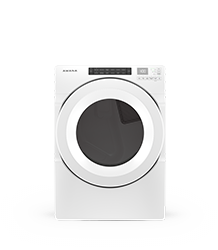Laundry 101
1. Measure Your Space

WASHER & DRYER
Measure the height, width and depth of the area designated for your new washer and dryer
W: side to side
Add 1″ on each side for air circulation.
D: back to front
Add at least 6″ to depth for door clearence, dryer vents, and hookups.
H: top to bottom
For top-loading washers, add at least 20″ for door clearance.
INSTALLATION SPACE
Decide where you will install your new washer and dryer. You will need:
- A level floor with no more that a 1″ slope
- A location that can support the installation of a dryer exhaust system
- Hot and cold water lines within 3′ of washer hookups
ENTRANCE & DOORWAYS
Measure the size of the doorways, hallways and other points of entry you’ll need to pass through when you bring in your new washer or dryer.

2. Additional Considerations
Is your dryer connection gas or electric?
There are two dryer types — gas and electric. Similar models look and perform the same, but differ in how they are set up. Your decision between the two will depend on where you will connect your new dryer:
Gas
Needs an approved gas line with shut off valve.
Electric
Needs a three-prong outlet with 30 amp circuit.

Choose Your Accessories
Pedestals
Create an area for storage and raise the washer and dryer for more convenient loading and unloading.
Cleaners
Keep your new washer fresh by removing odour and residue left behind by water and detergent using affresh® Washer Cleaner.

Pick a Colour and Finish
Models are available in:

Download the Laundry Guide
Evaluate the Features
WASHER
High-Efficiency
Save water, energy and the environment with High-Efficiency washers.
Water Level & Balance Sensors
Innovative features for less maintenance and worry.
DRYER
Wrinkle Reduction Options
Convenient options that help keep wrinkles out of clothes.
Moisture-Sensing Cycles
Moisture-sensing technology monitors dryness levels for efficient drying.

Important Considerations
Electric
Confirm that electrical output is sufficient for the location of your new washer and dryer. You will need:
- A grounded electrical outlet within 4’ of the rear of both machines (no extension cord or adaptor)
- A separate designated 30 amp circuit
- Set water heater to 120°F for washer
Gas
Your home should have:
- A CST International approved gas supply line
- A shut-off valve
- Disposal
Some retailers offer removal of your old machines when your new ones are delivered. Washers and dryers in good condition may be donated to a local charity.
Installation
Contact a licensed professional for installation. New installations may require significant carpentry, electrical and plumbing skills.

3. Washer Maintenance Guide
Because all clothes washers have the potential to accumulate some amount of mildew, bacteria and odour after a period of use, we recommend that you perform the following simple routine maintenance:
- Always follow the instructions in the use and care guide for your washing machine.
- Always leave the washer door or lid open between uses to help dry out the washer and prevent the buildup of odour-causing residue.
- Promptly remove laundry after the wash cycle has completed to avoid odor and rusting of metal objects on garments. Wet fabric left in a closed space is particularly conducive to the development of odour.
- Use only the amount of detergent recommended on the detergent container. If your washer is a high-efficiency machine, use only HE detergent, not regular detergent.
- Choose the warmest wash water temperature that is safe for the fabrics you are washing. Use of warm or hot water washers sometimes (not exclusively cold water washes) does a better job of controlling the rate at which soils and detergent accumulate.
- Regularly clean your washing machine. If specific cleaning instructions are not included in your use and care guide, it is a good practice to run an empty cycle (without laundry) once a month using hot water and liquid chlorine bleach or a commercially available washing machine cleaner, such as affresh® Washer Cleaner.
There are a number of factors that can contribute to the development of mildew, bacteria, and odours in washing machines, including the following:
- Not all of the water immediately evaporates after a load is complete.
- Washing machines generally are kept in somewhat closed and damp environments, such a laundry rooms and basements.
- The laundry that is put into washing machines has a wide variety of organic materials.
- Modern high-efficiency washing machines use less water and are more tightly sealed when the door or lid is closed.
- Modern high-efficiency washing machines are designed for use with specially-formulated, low-sudsing HE detergent. Regular detergent may cause excessive suds in high-efficiency machines, and excessive suds can leave a soap film that is conducive to the development of mildew, bacteria, and odour.
- Over time, laundry habits have changed, including the use of less bleach, more fabric softener, and more frequent cold water washes. These habits may increase the rate at which detergent and soil residue builds up inside the washer, which in turn may result in undesirable odour.








